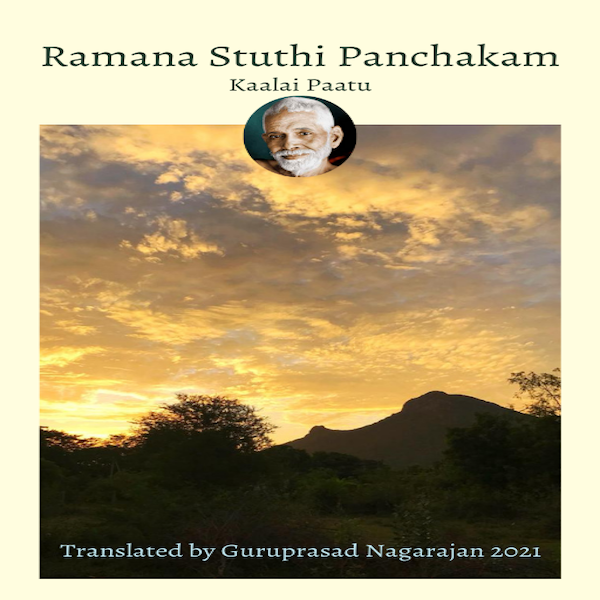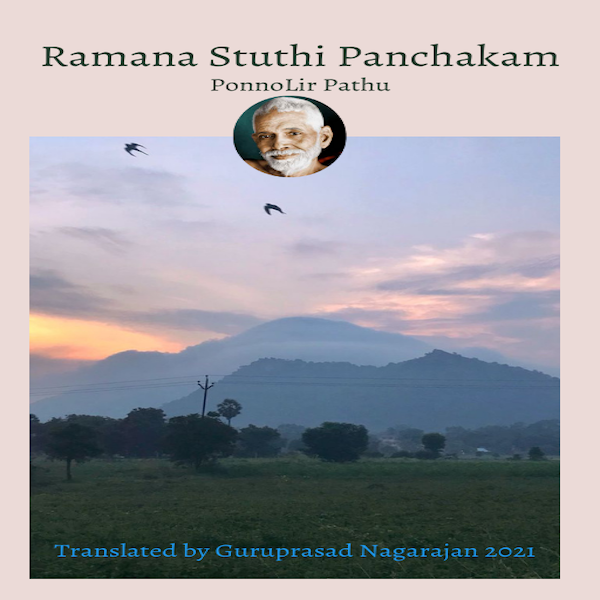RamaNa naavilu maeviya;
Uchi thachhuvai aana vunpadha
Muchchi vaithida vaendinen.
Word meaning
nachi = near/nearing; nindru = stand; navildhal = uttering; uchchi = top of head; padha = feet; vaendinen = (I) prayed.
Meaning
Oh Ramana, you who reside in my tongue as I come near you and utter these words. Please place your holy feet on top of my head (and bless me).
Here, ‘come near you’ is to be taken metaphorically, as in when a devotee approached Bhagavan (or comes nearer) through surrender and bhakti. Very few devotees have physically gone near Bhagavan, understandably so, because in early days everyone wanted to touch his feet or his body, which was a great inconvenience (Bhagavan recalled an incident in the very early days how some ladies came and broke coconut and poured the water over his head without asking if they could do so). This made his close devotees put up a barricade around his seat so he won’t be bothered by undue attention. The exception was in the animal kingdom. Some fortunate squirrels had the freedom to run over his body and thus get sparsa diksha (initiation by touch) while monkeys had a special place in Bhagavan’s ashram, they would eat freely from Bhagavan’s leaf plate when he was in Virupaksha Cave and Skandasram.
Still, there were a few blessed devotees who managed to get physically close to Bhagavan (From Sri Ramana’s Reminiscences):
“There was once a swami from North India. He was old and had stayed on for a few weeks. He must have been a very ripe soul because people could see an aura around him. On the day he was leaving, he stood before Bhagavan. I too was beside Bhagavan. The swami said, ‘I am very
happy, Bhagavan, that I got all that I wanted after coming to Arunachala and to your ashram. But I need two more things to be fulfilled and they can be done only by you.’ “All of us in the hall thought that the swami was going to get a very rude shock from Bhagavan. We waited with bated breath. Bhagavan, with a movement of his head, signalled the swami to continue. The swami, with folded hands, said, ‘My first request is that I want to place my head on your holy feet and melt. I want to wash your feet with my tears.’ Bhagavan waited, without uttering a word. ‘The second thing, Bhagavan,’ continued the swami, ‘you have to put your holy hands on me and declare that you have given me atma sakshatkar – liberation.’ We all laughed within ourselves because the swami had put forth such requests to Bhagavan. But a miracle took place. Bhagavan got up from the sofa and stood in front of him, pointing to his feet. The swami fell at Bhagavan’s feet. We saw his tears drenching the feet of Bhagavan. After a while, Bhagavan lifted him up, put his hands on his shoulders and declared, ‘I have given you atma sakshatkar.’ Though his eyes continued to shed tears, the swami’s face glowed with fulfillment as he took leave of Bhagavan!”
Another one:
Bhagavan once gave a similar display of grace to a sannyasin who came and stayed in the ashram for three weeks. On the last day of his stay he came near Bhagavan and said, ‘Swami, I am satisfied in every way with my stay in the ashram. Now, I pray, fill my heart.’ Bhagavan got up and held the sannyasin’s hands. They stood holding hands for a long time. Finally, the sannyasin prostrated before Bhagavan, said, ‘Now I am blessed,’ and left the ashram. Thus would Bhagavan give enlightenment with a word, a look, a touch or in deep silence.
For those of us who haven’t had the good fortune to see and hear Bhagavan when he was in his sthula sarira, we can take heart from the following observation from t.R.Kanakammal:
Today, I find people who have never seen Bhagavan physically, never heard his voice or listened to his upadesa, sit in the Old Hall or the Samadhi Hall, oblivious of themselves, often shedding tears, and going round the hall as if impelled by some unseen force. What gives these people their experiences?
As Bhagavan always said, "Is this body Bhagavan?"
When somebody expressed sadness at having to go back home from the Ashram, Bhagavan Sri Ramana said,
"What am I to do? You say that this body is Bhagavan. I say that it is not. Now, if you insist, what am I to do ? "
To others, he would say, "Look! He says he is going to a place where I am not."
These new devotees of Bhagavan are proof of all he told us.
To end this translation of Ramana Stuthi Panchakam, let us look at what Bhagavan said about how and why we are drawn to him
Somebody asked Bhagavan, ‘We have met at your feet, all of us. Was it our good luck, or is there a link between us from our previous births?’ Bhagavan replied in a quite matter-of-fact way: ‘Were it not for the old links, how could you all have come here?’
It is by the grace of Bhagavan and Periyava that it was possible to translate ‘Aksharamanamalai’ from TRK’s Nool Thirattu and Ramana Stuthi Panchakam for which relevant passages and information came ‘coincidentally’. Hope this work, done with my limited knowledge of both the languages, helps devotees understand these works of Bhagavan’s better. I take heart from Bhagavan’s words:
Sri Bhagavan also commended the art of translation especially of a great work. He said, “Ten times’ attentive reading is writing. Hundred times’ writing is translating.” Subbaramayya, Gurram. Sri Ramana Reminiscences







 RSS Feed
RSS Feed